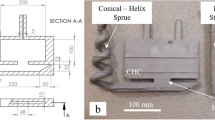Abstract
An efficient deflocculant for a conventional refractory castable based on a chamotte filler is proposed. Aparticle distribution analysis is given for a dry castable mix containing microsilica, and the physicomechanical properties of the conventional refractory castable modified with microsilica and Castament FS40 polycarboxylate deflocculant are studied.
Similar content being viewed by others
References
J. Pešek, B. Korsa, and F. Fajfr, “The dependence of mixing water on physical properties of high density refractory NC, ULC and MC castables,” in: XIV International Conference on Refractory Castables, 23–24 October, 2001, Prague (2001), pp. 106–113.
P. G. Vasilik, “New dispersants (deflocculants) for refractory castables,” Novye Ogneupory, No. 8, 28–31 (2003)
G. Routshka, D.-M. Daichendt, and K. Wutz, “New plasticizer for ultralow cement andalusite and bauxite refractory castables,” Interceram., 49(5), 356–358 (2000).
H. Hommer, “Studies on a binder matrix of refractory castables — influence of dispersants on flow characteristics,” CN Refractories, 6(1), 46–50 (2002).
J. Von Seyerl, “Dispersant and fine aluminas: a new way to tailor flow, setting time and strength development in castable mix design,” in: Interceram. Refractories Manual (2005), pp. 46–47.
B. Sandberg and B. Myhre, “Microsilica, a versatile refractory raw material,” in: Elkem A/S Refractories Report in India Refractories Congress (1994), pp. 1–7.
ASTM C 860-91. Standard Practices for Determining and Measuring Consistency of Refractory Concretes.
H. Hommer and K. Wutz, “Recent developments in deflocculants for castables,” in: 9th Biennal Worldwide Congress on Refractories (2005).
Lisa-Size Distribution Analyzer. Available on-Line at www.elkem.com.
W. Shulle, J. Ulbricht, and A. Altun, “Investigations in the development of self-flowing basic castables,” Ceram. Forum Int., 78(5), 39–42 (2001).
S. Goberis, I. Pundene, A. Špouskas, et al., “A study into the role of microsilica in binding medium-cement refractory castables,” Ogneup. Tekh. Keram., No. 2, 8–14 (2003).
Author information
Authors and Affiliations
Additional information
__________
Translated from Novye Ogneupory, No. 5, pp. 44–48, May, 2006.
Rights and permissions
About this article
Cite this article
Antonovich, V., Goberis, S., Pundene, I. et al. A new generation of deflocculants and microsilica used to modify the properties of a conventional refractory castable based on a chamotte filler. Refract Ind Ceram 47, 178–182 (2006). https://doi.org/10.1007/s11148-006-0083-0
Received:
Issue Date:
DOI: https://doi.org/10.1007/s11148-006-0083-0




